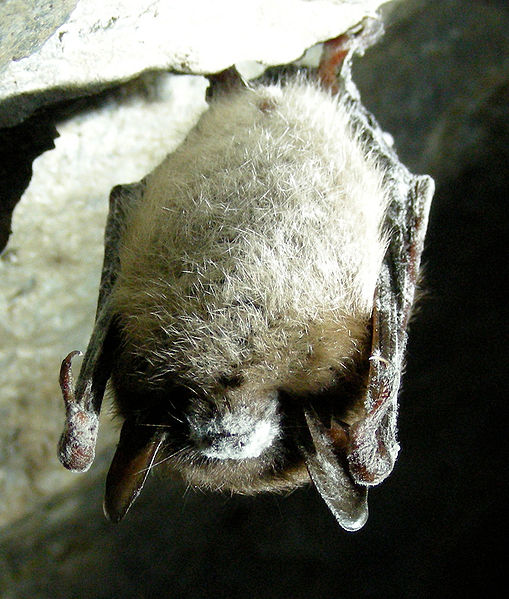Science News
The Bat Bunker
October 2, 2012
by Zuberoa Marcos

(Scroll down for Spanish version)
White-nose syndrome has killed millions of North American bats. Now a team of U.S. scientists at The Nature Conservancy has built the first artificial cave in Tennessee to save them. The cave will open to the bats this fall.
About 5.7 million bats have already succumbed to white-nose disease in the US, according to the best estimates from state and federal wildlife officials. Originated by the aggressive Geomyces destructans fungus, it damages the bats’ wings and causes them to wake up when they should be hibernating. This burns their fat reserves too early, and the animals either starve to death or try to leave their caves in the dead of winter in search of food, often dying of exposure.
To date, there is no known treatment and the bats’ drastic decline has broad implications: the animals eat their weight in mosquitoes and other insects each day. By some estimates, they save American agriculture $3.7 billion annually.
The Nature Conservancy’s new hibernaculum hopes to protect bat populations. Made out of pre-cast concrete modules, it lies more than a meter below ground, stretches 24 meters in length, and could easily accommodate 200,000 bats.
To adapt to bats’ requirements, the cave was engineered to draw a continual supply of winter air from a concrete shaft to provide the chilly temperatures preferred by hibernating bats. The ceiling is scored with ridges and rough edges to give bat claws a tight grip. A rainwater pipe will bring in moisture to maintain the cave’s humidity levels and provide drinking water, and an air chimney will provide ventilation. Two 1.5-ton air conditioning units will run for the next few weeks to drop the cave’s temperature to the required range, between 41°F and 50°F.
The artificial cave won’t keep out the white nose fungus, but each autumn and spring, scientists plan to scrub it out with ammonia to keep it clean. Such a sanitizing procedure can’t be used in a natural cave environment because it would kill everything else and be detrimental to the ecosystem.
If the bat cave works, it will provide a new rescue plan for other endangered species. But there are no guarantees the bats will come in and use the artificial space. If they do, three surveillance cameras with infrared imaging will allow researchers to monitor bat movements without disturbing them. If they don’t, The Nature Conservancy’s experts can still use the cave as a field laboratory. They might bring some bats into the cave for testing new fungicides.
Zuberoa Marcos is a former biologist and current science writer based in Barcelona. She writes articles regularly for Science Today.
Un bunker para murciélagos
Por Zuberoa Marcos
El síndrome de la nariz blanca ha acabado con la vida de millones de murciélagos en Norteamérica. Un equipo de científicos estadounidenses de la organización The Nature Conservancy acaba de construir, en Tennessee, la primera cueva artificial para salvar a los que quedan. Empezará a funcionar este otoño.
Según estimaciones oficiales, alrededor de 5,7 millones de murciélagos en los EE.UU han sucumbido ya al síndrome de la nariz blanca. La enfermedad, originada por el hongo Geomyces destructans, daña las alas de los murciélagos y provoca que éstos se despierten cuando deberían estar hibernando. Esto hace que los animales quemen sus reservas de grasa demasiado pronto y, hambrientos, tengan que salir de la cueva, en pleno invierno, en busca de alimentos. Es una excursión mortal. Muchos de los murciélagos mueren por la exposición al frío.
Hasta la fecha, no existe un tratamiento para el síndrome de la nariz blanca a pesar de que esta drástica disminución del número de murciélagos tiene importantes consecuencias: los animales comen, cada día, su peso en mosquitos y otros insectos capaces de dañar los cultivos. Según algunas estimaciones, los murciélagos ahorran la agricultura americana 3.700 millones de dólares al año.
El nuevo hibernáculo protegerá a las poblaciones de murciélagos. Construido con módulos de hormigón prefabricados, está enterrado a un metro bajo tierra, tiene 24 metros de largo y podrá acomodar hasta a 200.000 murciélagos.
Para adaptarse a las necesidades de estos animales, la cueva ha sido diseñada para proporcionar un suministro constante de aire invernal y, con ello, las bajas temperaturas que les gustan a los murciélagos para hibernar. El techo consta de cantos y bordes ásperos para que los animales puedan agarrarse a ellos. Una tubería de agua de lluvia se encarga de mantener los niveles de humedad de la cueva y de proporcionar agua potable y una chimenea de aire de la ventilación. En las próximas semanas, dos equipos de aire acondicionado de 1.5 toneladas se encargarán de bajar la temperatura de la cueva hasta el rango necesario, entre 41 y 50 ° F.
La cueva artificial no impedirá que el hongo G. destructans entre en ella pero, cada primavera y cada otoño, los científicos la desinfectarán con amoniaco para mantenerla limpia. Este procedimiento de saneamiento no sería posible en una cueva natural, ya que sería perjudicial para el ecosistema y mataría al resto de habitantes de la misma.
Si la cueva artificial funciona, proporcionará una nueva estrategia para salvar a otras especies en peligro de extinción. Sin embargo, no hay garantías de que los murciélagos vayan a entrar y a utilizar el nuevo espacio artificial. Si lo hacen, tres cámaras de vigilancia infrarrojas permitirán a los investigadores vigilar los movimientos de los murciélagos sin molestarlos. Si ningún animal se instala en la cueva, los expertos de The Nature Conservancy podrán utilizarla como laboratorio, por ejemplo, introduciendo algunos murciélagos para probar nuevos fungicidas.
Zuberoa Marcos es bióloga molecular y actualmente trabaja como productora de TV y periodista científica. Escribe de forma regular para Science Today.